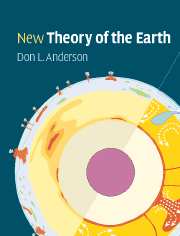Book contents
- Frontmatter
- Contents
- Preface and Philosophy
- Abbreviations and acronyms
- Part I Planetary perspective
- Part II Earth: the dynamic planet
- Part III Radial and lateral structure
- Part IV Sampling the Earth
- Part V Mineral physics
- Chapter 18 Elasticity and solid-state geophysics
- Chapter 19 Dissipation
- Chapter 20 Fabric of the mantle
- Chapter 21 Nonelastic and transport properties
- Chapter 22 Squeezing: phase changes and mantle mineralogy
- Part VI Origin and evolution of the layers and blobs
- Part VII Energetics
- References and notes
- Appendix
- Index
Chapter 22 - Squeezing: phase changes and mantle mineralogy
Published online by Cambridge University Press: 05 June 2012
- Frontmatter
- Contents
- Preface and Philosophy
- Abbreviations and acronyms
- Part I Planetary perspective
- Part II Earth: the dynamic planet
- Part III Radial and lateral structure
- Part IV Sampling the Earth
- Part V Mineral physics
- Chapter 18 Elasticity and solid-state geophysics
- Chapter 19 Dissipation
- Chapter 20 Fabric of the mantle
- Chapter 21 Nonelastic and transport properties
- Chapter 22 Squeezing: phase changes and mantle mineralogy
- Part VI Origin and evolution of the layers and blobs
- Part VII Energetics
- References and notes
- Appendix
- Index
Summary
It is my opinion that the Earth is very noble and admirable … and if it had contained an immense globe of crystal, wherein nothing had ever changed, I should have esteemed it a wretched lump of no benefit to the Universe.
GalileoOverview
Before one can infer the composition of the mantle from physical properties, one must deal with the mineralogy of the mantle, and the role of partial melting and solid–solid phase changes. These issues straddle the disciplines of petrology and mineral physics. Pressure-induced phase changes and chemical variations are important in understanding the radial structure of the Earth. The advent of tomography has made it important to understand lateral changes in physical properties. Phase changes and compositional changes are probably more important than temperature changes in the interpretation of tomographic images. Tomographic cross-sections are not maps of temperature.
The densities and seismic velocities of rocks are relatively weak functions of temperature, pressure and composition unless these are accompanied by a drastic change in mineralogy. The physical properties of a rock depend on the proportions and compositions of the various phases or minerals – the mineralogy. These, in turn, depend on temperature, pressure and composition. In general, one cannot assume that the mineralogy is constant as one varies temperature and pressure. Lateral and radial variations of physical properties in the Earth are primarily due to changes in mineralogy.
- Type
- Chapter
- Information
- New Theory of the Earth , pp. 282 - 298Publisher: Cambridge University PressPrint publication year: 2007



